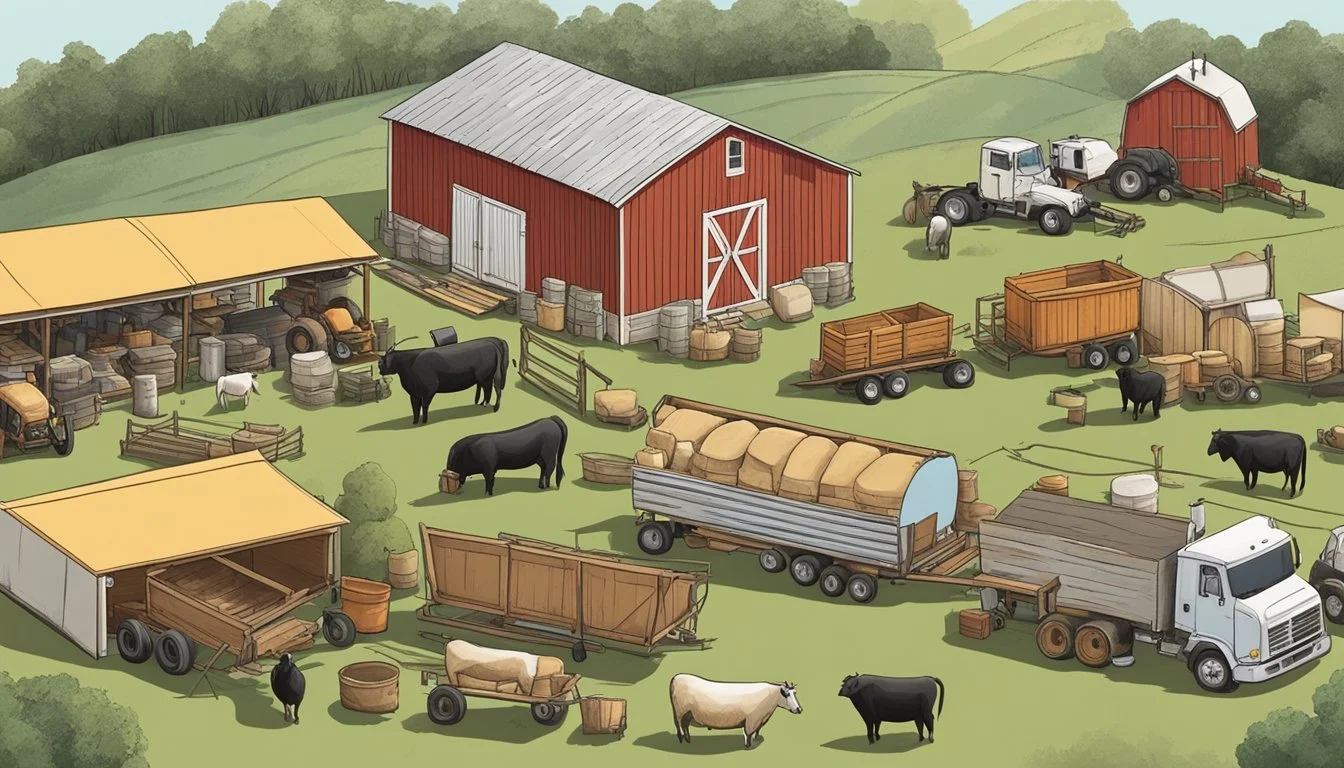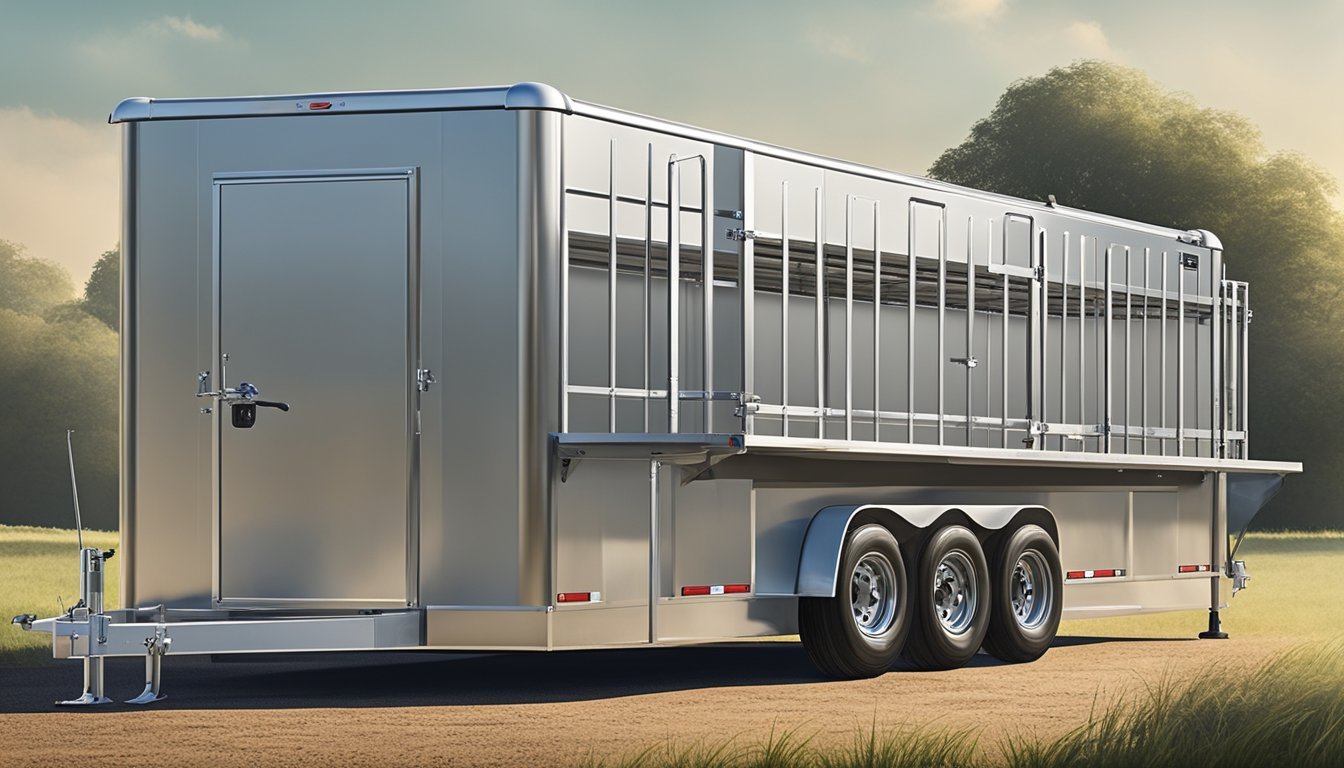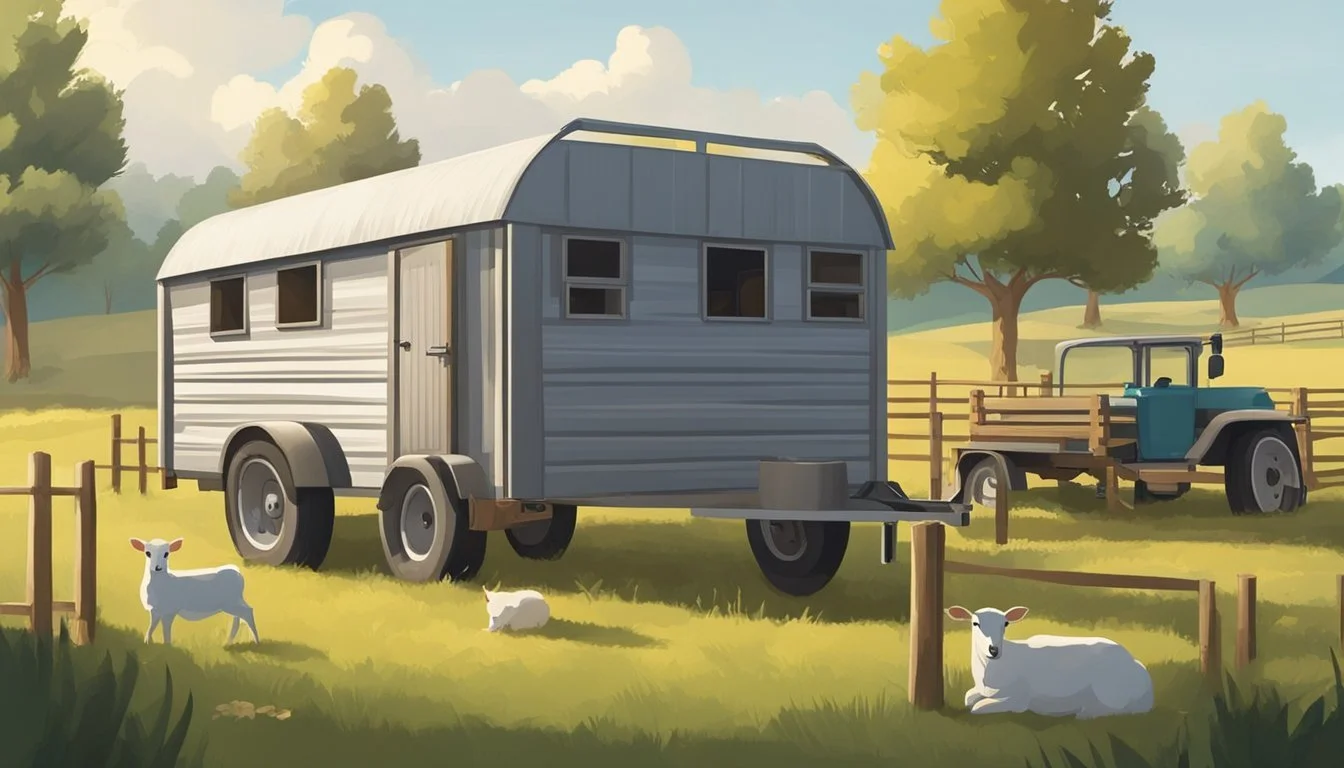Essential Tips for Choosing the Best Livestock Trailer for Homesteading
Key Considerations
Selecting the right livestock trailer is a crucial decision for homesteaders who aim to transport their animals safely and efficiently. The market offers a diverse range of trailers, each with specific features tailored to different needs and types of livestock. Material selection is an important factor; options like aluminum are favored for their rust resistance and lighter weight, making them easier to tow, whereas steel is known for its durability despite being heavier and more susceptible to rust. It's also essential to consider the various trailer structures available, such as bumper pull trailers, which are user-friendly and affordable, and gooseneck trailers, which provide stability for heavier loads.
Homesteaders must also pay attention to the size and internal configurations of the trailer. Adequate space is necessary to ensure the comfort and welfare of the animals during transportation. Trailers must allow for sufficient headroom and feature adjustable dividers to adapt to different sizes and numbers of livestock. Ensuring the well-being of the animals is paramount, therefore, including features that promote safety, such as proper ventilation and secure latching mechanisms, is indispensable. A well-chosen livestock trailer will not only facilitate the transportation task but also reflect the homesteader's commitment to their livestock's health and safety.
Understanding Livestock Trailer Types
Choosing the right type of livestock trailer is crucial for the efficiency and safety of transporting animals. This section will discuss different trailer styles, each offering distinct advantages depending on the intended use and livestock being hauled.
Gooseneck Trailers
Gooseneck trailers are distinguished by their extended front that hooks over a ball hitch in the bed of a towing truck. They offer superior stability and are preferred for hauling large herds due to their larger size and improved maneuverability over long distances. These trailers typically demand a more capable towing vehicle and can have a higher initial cost.
Bumper Pull Trailers
Bumper pull trailers, also known as tag-along trailers, are attached to a hitch on the rear bumper of the towing vehicle. They are more compact compared with gooseneck trailers and can be an excellent choice for smaller loads and short distances. Bumper pull trailers are usually less expensive and can be towed by a wide range of vehicles, not requiring a specialized truck bed hitch.
Stock Trailers
Stock trailers are versatile units designed to transport a variety of livestock. They come with features like adjustable dividers that can be rearranged to fit different types and sizes of animals, ensuring comfort and safety during transit. Ventilation systems are also an integral part of stock trailers, providing necessary airflow for the animals.
Horse Trailers
Horse trailers are specifically tailored to the needs of equines. They are often outfitted with padding and other features that provide stability and comfort for horses during travel. Some horse trailers come with living quarters for people, making them a popular option for equestrian enthusiasts traveling to events or relocating.
Customized Trailers
For homesteaders with specific requirements, customized trailers can be built to order. These trailers can include features tailored to particular types of animals or additional accommodations for long-haul journeys. Customization tends to increase the cost but can offer solutions that standard trailers do not provide.
Selecting the Right Size and Capacity
When choosing a livestock trailer, it is essential to consider both the size appropriate for your animals and the payload capacity your towing vehicle can handle.
Determine Your Livestock Needs
The size of your livestock trailer should be directly tailored to the type and number of animals you intend to transport. For cattle and horses, which are generally larger, more headroom and compartment space are needed. A common guideline suggests at least 10 inches of clearance above the tallest animal's head. Conversely, smaller livestock such as sheep, goats, and pigs may require less height but still need sufficient space to prevent overcrowding.
Cattle/Horses: Provide at least 10 inches of headroom above the animal.
Sheep/Goats/Pigs: Require less height but adequate room to prevent stress and injury.
For those transporting mixed types, such as horses with ponies, the trailer design should accommodate the different space needs of each species. Ensuring that each animal has enough room not only promotes their well-being during transport but is also critical for safety.
Towing Capacity and Vehicle Compatibility
Before purchasing a trailer, the towing capacity of your vehicle must be verified to ensure it can handle the desired payload capacity of the trailer when fully loaded. A pickup truck is a typical choice for towing livestock trailers due to their substantial towing capacities.
Payload Capacity: Key consideration for the trailer's capability to hold the weight of the livestock.
Towing Capacity: Must align with your vehicle's specifications to avoid overloading.
Check the vehicle's owner's manual for the towing capacity, usually expressed in pounds. Your trailer's weight when loaded with livestock should not exceed this number. Overloading can lead not only to vehicle damage but also to dangerous driving conditions. A suitable match between truck and trailer ensures a safe and efficient transport experience.
Budget Considerations and Financing Options
When selecting a livestock trailer, understanding the full financial impact is crucial. One must consider the initial purchase price, ongoing expenses, and financing avenues to make an informed decision.
Estimating Initial Purchase Price
The initial purchase price of a livestock trailer can vary significantly based on size, materials, and features. Aluminum trailers are typically lighter and resistant to rust, offering a balance between durability and cost. On the other hand, steel trailers are more affordable but heavier and prone to rust, whereas galvanized steel trailers provide rust resistance but come with a higher price tag. A buyer should expect to make a down payment of 10-20% of the total cost.
Aluminum Trailers: Generally lighter, rust-resistant. Mid-range cost.
Steel Trailers: High durability. Lower cost, heavier, rust prone.
Galvanized Steel Trailers: Rust-resistant, higher initial cost.
Long-Term Costs and Value
Ownership extends beyond the purchase price. Trailers made from materials like aluminum may offer better "fuel efficiency" due to their lighter weight. Long-term costs also include maintenance, repairs, and potential modifications. Buyers should examine the longevity of different trailers against their budget constraints, weighing initial costs against long-term value to ensure cost-effectiveness.
Maintenance/Repairs: Factor in regular upkeep and potential repairs.
Fuel Efficiency: Lighter trailers can lead to cost savings on fuel.
Resale Value: Consider trailers with better longevity for higher resale.
Financing Solutions
Finding the right lender is key when financing a livestock trailer. Buyers with limited capital can find lenders willing to work with various down payments and credit situations. It is advisable to explore options like bank loans, trailer dealer financing, or credit unions. Monthly payments will be determined by the down payment, interest rates, and the loan's term, and buyers should carefully compare the terms offered by different financial institutions.
Down Payment: Lower monthly payments with larger down payment.
Loan Terms: Compare interest rates and terms from multiple lenders.
Monthly Payment: Ensure the payment plan fits your budget.
Features for Livestock Comfort and Safety
When choosing a livestock trailer, the comfort and safety of the animals are paramount. Specific features are designed to reduce stress, provide a stable environment, and ensure that livestock can be transported without harm.
Ventilation and Climate Control
Ventilation is critical for maintaining a healthy climate within the trailer, as proper airflow prevents overheating and minimizes the buildup of harmful gases. Good ventilation systems might include:
Roof vents that allow hot air to escape.
Side openings with adjustable covers to regulate airflow and temperature.
Climate control systems for extreme temperatures, ensuring animals are not exposed to excessive heat or cold.
Flooring and Stability
The flooring material in a livestock trailer is important for both comfort and stability. It should be:
Made of a non-slip surface to prevent falls during transport, such as rubber mats or ridged aluminum.
Easy to clean to prevent disease spread.
Sufficiently cushioned to reduce stress on the animals' joints.
Safety Features
Safety aspects of a livestock trailer protect both the livestock and the handlers. These can include:
Interior dividers that are adjustable to suit different sizes of livestock, ensuring they are securely partitioned during transport.
Solid and durable side walls to prevent animals from sticking out limbs.
Rear doors that provide easy and safe loading and unloading, potentially with a ramp for animals that are not accustomed to step up high.
Emergency exits that allow for quick and safe removal of the animals in case of an accident.
Materials and Construction for Durability
When selecting a livestock trailer for homesteading, the durability of the trailer is a prime consideration. This durability largely depends on the materials used in the trailer's construction and how they are engineered for strength and longevity.
Steel Versus Aluminum Trailers
Steel is well-regarded for its extreme durability and strength, making it a solid choice for a livestock trailer. However, it is also notably heavier than aluminum and prone to rust. In contrast, aluminum is much lighter, facilitating easier towing and fuel efficiency. Although less heavy-duty than steel, aluminum is resistant to rust and generally affordable, making it a worthwhile option for many homesteaders.
Galvanized Steel Benefits
Galvanized steel offers a compromise, presenting the durability of steel with added rust resistance. It is steel that has been coated in a layer of protective zinc to prevent corrosion. It stands out for being stronger than aluminum and more resilient against rust compared to untreated steel, though it does come at a higher cost.
Composite Materials
Composite materials are increasingly popular due to their ability to provide balanced benefits. Trailers made from composites can offer a good compromise between durability and affordability, with the added advantage of being lighter in weight compared to traditional steel. This category can include a range of material combinations, designed to maximize strength while minimizing weaknesses that single-material trailers may face.
Ease of Usage for Homesteading Success
Choosing the right livestock trailer is crucial for the successful operation of a homestead. The ease of usage encompasses factors such as handling and maneuverability, maintenance and cleaning, as well as the processes involved in loading and unloading livestock. These factors significantly impact the efficiency and safety of transporting animals.
Handling and Maneuverability
When selecting a livestock trailer, one must consider handling and maneuverability. Trailers with responsive steering and appropriate tire quality ensure smoother transitions from farms to markets. A well-designed trailer should feature:
Tight turning radius: This allows for easier backing up and positioning.
Quality tires: Proper tires contribute to safe and reliable handling, especially on uneven rural roads.
Maintenance and Cleaning
Maintenance and cleaning are vital for the longevity of a livestock trailer and the health of the animals. A trailer with accessible features for cleaning will prevent the build-up of harmful bacteria and ensure a hygienic environment. Key considerations include:
Non-corrosive materials: These reduce long-term wear and simplify the cleaning process.
Easily removable components: Simplifies thorough cleaning and allows for proper drying and storage.
Livestock Loading and Unloading
The process of loading and unloading livestock is paramount when assessing a trailer's usability. Efficient designs must minimize stress on the animals and the handler. Essential features should incorporate:
Low-angle ramps: Facilitates easier and safer movement of livestock in and out of the trailer.
Ample doorways and partitions: They optimize space and improve the flow during loading and unloading.
Meeting the Unique Needs of Your Livestock
When selecting the best livestock trailer for homesteading, the unique needs of your animals are paramount. Livestock such as cattle, horses, and sheep require different accommodations in a trailer.
Cows and cattle, for instance, need sturdy partitions that can withstand their weight and strength. These partitions are crucial to keep them secure and prevent injury during transport. Similarly, horses and ponies, which are often more prone to stress, benefit from ample space and features that reduce noise and vibrations.
For sheep and goats, ventilation is especially important to prevent overheating, as is the ability to see their surroundings to some extent to ease anxiety. On the other hand, pigs require strong, easy-to-clean surfaces due to their nature and the potential for waste products.
Poultry such as chickens, ducks, and turkeys, require enclosed spaces that protect them from external elements and provide ventilation while preventing escape.
It's also important to consider the feeding requirements when transporting livestock. Animals that are used to grazing or require bulky feed like alfalfa, hay, or grain need enough space to accommodate food for longer journeys to maintain their diet, crucial for both meat and dairy production.
Here's a quick reference for trailer features based on livestock type:
Cows/Cattle: Suggested Trailer Features - Sturdy Partitions, Ample Space
Horses/Ponies: Suggested Trailer Features - Noise-reduction, Smooth Ride
Sheep/Goats: Suggested Trailer Features - Ventilation, Visual Contact
Pigs: Suggested Trailer Features - Durable, Easy-to-clean Surfaces
Poultry: Suggested Trailer Features - Secure Enclosure, Ventilation
In summary, each species has specific needs that must be considered to ensure their comfort, safety, and stress minimization. Careful evaluation of these factors will lead to the selection of a livestock trailer that will best suit the varied and particular requirements of your homestead animals.
Complementary Equipment and Supplies
Selecting the right complement of equipment and supplies is crucial for the efficiency and safety of transporting livestock. These essentials ensure that the transportation process is stress-free for both the homesteader and the animals.
Tack and Feed Storage
Adequate storage for tack and feed is essential to keep supplies organized and accessible during transport. For convenience, many homesteaders opt for built-in compartments within the trailer. These should be designed to store an array of supplies securely:
Grain: Airtight compartments to prevent spoilage.
Hay and Alfalfa: Racks or mesh bags that allow ventilation while minimizing waste.
Watering Systems
Proper hydration is critical for livestock during transport. Installing a reliable watering system can help maintain the animals' well-being on longer journeys. Essential features to consider include:
Non-spill water troughs that can be easily refilled without opening the trailer.
High-capacity storage tanks to ensure a sufficient water supply.
Security Measures
The security aspect encompasses not just the safety of the livestock but also the prevention of equipment theft. Key security equipment includes:
Sturdy locks on all storage compartments to deter theft.
Secure pins on gate latches that are designed to prevent accidental opening while the trailer is in motion.
Legal and Safety Regulations
When selecting a livestock trailer for homesteading purposes, it is imperative to consider the stringent legal and safety regulations that govern transportation and towing. Compliance with these rules ensures both the welfare of animals during transport and adherence to legal requirements.
Transportation Laws
Transportation laws for livestock trailers are both federal and state-specific, and they outline the legalities of towing safety, weight limits, and animal welfare during transit. Before hitting the road, one must be acutely aware of:
Towing Limits: Check your vehicle's towing capacity to ensure it matches or exceeds the Gross Vehicle Weight Rating (GVWR) of the trailer, including its load.
Hitch Requirements: A bumper pull trailer typically requires a different hitch setup than a gooseneck trailer. The former relies on a standard trailer hitch, while the latter must be connected to a ball hitch in the bed of a truck.
Transport Parameters: Hours of operation, rest periods for animals, and proper loading techniques are dictated by law and vary by state.
Inspections and Certifications
To guarantee safety and legal compliance, livestock trailers must undergo regular inspections and hold certain certifications.
Periodic Inspections: They are mandated to check structural integrity, braking systems, lighting, and other safety features.
Certification of Roadworthiness: This acknowledgment is oftentimes necessary and is obtained post thorough inspection.
By ensuring that all legal and safety regulations regarding transportation laws, hitch requirements, and regular inspections are met, homesteaders can confidently transport their livestock in a manner that is safe and compliant with all applicable guidelines.
Planning for the Future
When selecting a livestock trailer for homesteading, it's important to consider not just current needs but also future expansion and multipurpose use. A trailer that grows with your homestead ensures long-term success and proves to be a dependable investment.
Expandability Options
Expandability is crucial for homesteaders who anticipate growth in their livestock numbers. A trailer's design should allow for:
Modular Panels: Panels that can be added or removed provide flexibility in adjusting the space for more animals.
Foldable Sections: Sections that fold down can convert areas within the trailer for additional storage or carrying more livestock when needed.
When considering a trailer for long-term use, check if the manufacturer offers compatible expansion kits or if the design is standard, allowing for easy modifications.
Adaptability for Different Uses
A versatile livestock trailer can serve multiple purposes on a homestead. Key features indicating adaptability:
Convertible Spaces: Look for trailers with sections that can be converted into a living quarters or additional storage for equipment.
Flooring Systems: Durable, easy-to-clean flooring systems that can be adapted for different types of livestock.
Ventilation Adjustments: Proper ventilation is crucial for animal welfare, and adaptable systems can cater to various requirements and weather conditions.
Choosing a trailer with these adaptability features ensures it can support a range of activities, giving homesteaders the flexibility to tackle different tasks efficiently.









